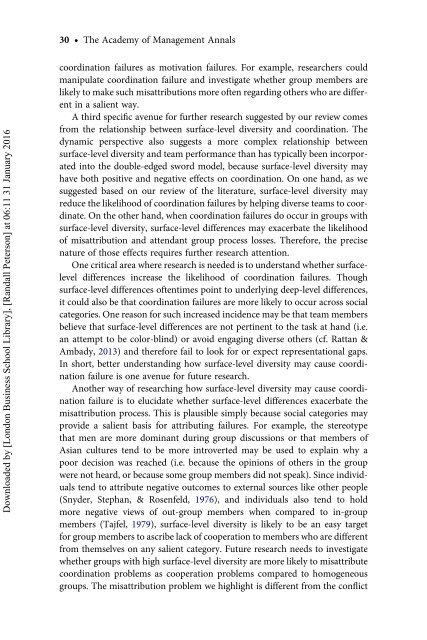A Dynamic Perspective on Diverse Teams: Moving From The Dual Process Model to A Dynamic Coordination-Based Model of Diverse Team Performance - Kannan Srikanth, Sarah Harvey & Randall Peterson
The existing literature on diverse teams suggests that diversity is both helpful to teams in making more information available and encouraging creativity and damaging to teams in reducing cohesion and information sharing. Thus the extant literature suggests that diversity within teams is a double-edged sword that leads to both positive and negative effects simultaneously.
The existing literature on diverse teams suggests that diversity is both helpful to teams in making more information available and encouraging creativity and
damaging to teams in reducing cohesion and information sharing. Thus the
extant literature suggests that diversity within teams is a double-edged sword
that leads to both positive and negative effects simultaneously.
You also want an ePaper? Increase the reach of your titles
YUMPU automatically turns print PDFs into web optimized ePapers that Google loves.
30 † <strong>The</strong> Academy <strong>of</strong> Management Annals<br />
Downloaded by [L<strong>on</strong>d<strong>on</strong> Business School Library], [<strong>Randall</strong> Peters<strong>on</strong>] at 06:11 31 January 2016<br />
coordinati<strong>on</strong> failures as motivati<strong>on</strong> failures. For example, researchers could<br />
manipulate coordinati<strong>on</strong> failure and investigate whether group members are<br />
likely <strong>to</strong> make such misattributi<strong>on</strong>s more <strong>of</strong>ten regarding others who are different<br />
in a salient way.<br />
A third specific avenue for further research suggested by our review comes<br />
from the relati<strong>on</strong>ship between surface-level diversity and coordinati<strong>on</strong>. <strong>The</strong><br />
dynamic perspective also suggests a more complex relati<strong>on</strong>ship between<br />
surface-level diversity and team performance than has typically been incorporated<br />
in<strong>to</strong> the double-edged sword model, because surface-level diversity may<br />
have both positive and negative effects <strong>on</strong> coordinati<strong>on</strong>. On <strong>on</strong>e hand, as we<br />
suggested based <strong>on</strong> our review <strong>of</strong> the literature, surface-level diversity may<br />
reduce the likelihood <strong>of</strong> coordinati<strong>on</strong> failures by helping diverse teams <strong>to</strong> coordinate.<br />
On the other hand, when coordinati<strong>on</strong> failures do occur in groups with<br />
surface-level diversity, surface-level differences may exacerbate the likelihood<br />
<strong>of</strong> misattributi<strong>on</strong> and attendant group process losses. <strong>The</strong>refore, the precise<br />
nature <strong>of</strong> those effects requires further research attenti<strong>on</strong>.<br />
One critical area where research is needed is <strong>to</strong> understand whether surfacelevel<br />
differences increase the likelihood <strong>of</strong> coordinati<strong>on</strong> failures. Though<br />
surface-level differences <strong>of</strong>tentimes point <strong>to</strong> underlying deep-level differences,<br />
it could also be that coordinati<strong>on</strong> failures are more likely <strong>to</strong> occur across social<br />
categories. One reas<strong>on</strong> for such increased incidence may be that team members<br />
believe that surface-level differences are not pertinent <strong>to</strong> the task at hand (i.e.<br />
an attempt <strong>to</strong> be color-blind) or avoid engaging diverse others (cf. Rattan &<br />
Ambady, 2013) and therefore fail <strong>to</strong> look for or expect representati<strong>on</strong>al gaps.<br />
In short, better understanding how surface-level diversity may cause coordinati<strong>on</strong><br />
failure is <strong>on</strong>e avenue for future research.<br />
Another way <strong>of</strong> researching how surface-level diversity may cause coordinati<strong>on</strong><br />
failure is <strong>to</strong> elucidate whether surface-level differences exacerbate the<br />
misattributi<strong>on</strong> process. This is plausible simply because social categories may<br />
provide a salient basis for attributing failures. For example, the stereotype<br />
that men are more dominant during group discussi<strong>on</strong>s or that members <strong>of</strong><br />
Asian cultures tend <strong>to</strong> be more introverted may be used <strong>to</strong> explain why a<br />
poor decisi<strong>on</strong> was reached (i.e. because the opini<strong>on</strong>s <strong>of</strong> others in the group<br />
were not heard, or because some group members did not speak). Since individuals<br />
tend <strong>to</strong> attribute negative outcomes <strong>to</strong> external sources like other people<br />
(Snyder, Stephan, & Rosenfeld, 1976), and individuals also tend <strong>to</strong> hold<br />
more negative views <strong>of</strong> out-group members when compared <strong>to</strong> in-group<br />
members (Tajfel, 1979), surface-level diversity is likely <strong>to</strong> be an easy target<br />
for group members <strong>to</strong> ascribe lack <strong>of</strong> cooperati<strong>on</strong> <strong>to</strong> members who are different<br />
from themselves <strong>on</strong> any salient category. Future research needs <strong>to</strong> investigate<br />
whether groups with high surface-level diversity are more likely <strong>to</strong> misattribute<br />
coordinati<strong>on</strong> problems as cooperati<strong>on</strong> problems compared <strong>to</strong> homogeneous<br />
groups. <strong>The</strong> misattributi<strong>on</strong> problem we highlight is different from the c<strong>on</strong>flict
















